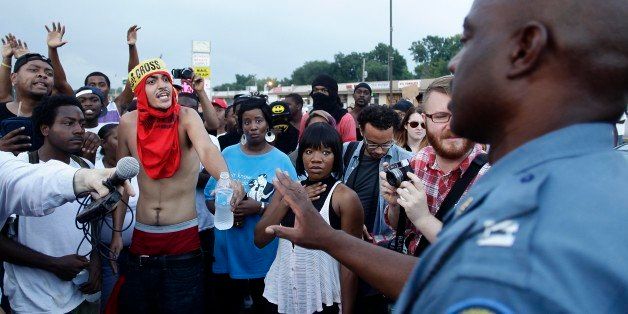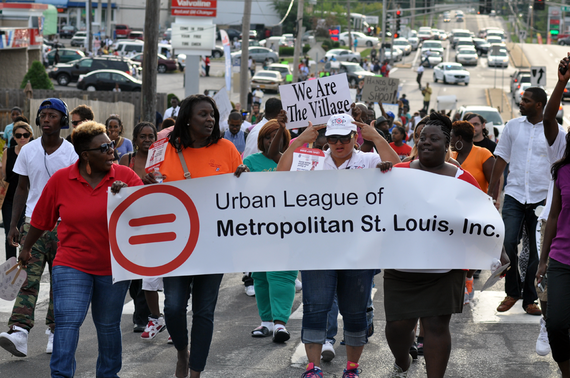

Photo: By Loaves of Bread, Creative Commons License.
The real Ferguson story is about a community that's grown so fed up with being pushed around that they've decided to fight back against what amounts to an invading army.
It is a confrontation for justice in the best tradition of Ghandi, the Civil Rights Movement and Tahir Square.
A community armed with little less than their deep sense of indignation saying "enough is enough" and defying a deeply unjust and increasingly violent system.
It goes far beyond the atrocious killing by the Ferguson police of Michael Brown, an 18-year-old unarmed black male, because depressingly so, such killings happen all the time. Melissa Harris Perry, in her moving MSNBC piece, pointed out that:
From 2006 to 2012, a white police officer killed a black person at least twice a week in this country. Which brings us back to Ferguson, Missouri, where according to a report in The Daily Beast, in 2009 police officers charged a man for property damage because he bled on their uniforms while they arrested him-and allegedly beat him bloody.
It is not about character assassination -- vilifying the victim in an attempt to justify the killing, because it's been done for ever. Most recently in the case of Trayvon Martin. Historically, it was a tool routinely used by Rudolph W. Guiliani when he was Mayor of New York.
Neither it is about institutionalized racism that, 60 years after signing of the Civil Rights Bill and 6 into the presidency of the first African American, nails shut most doors to the black and brown people of this land, because people like Tavis Smiley have been saying it for long. Just last October, he pointed out that
[...] sadly that when the Obama administration is over, black people will have lost ground in every single leading economic indicator category.
And while the "militarization of the police" under the Pentagon's 1033 Program, seen in recent days in its raw brutality, has led to newscasts, reports and editorials, it is not news because others have been writing about it.
As far back as 9/12/11 Radley Balko had published an extensive article in the Huffington Post discussing this very same subject, a topic that has surfaced back and again over the years and across a broad spectrum of progressive and liberal publications. He wrote that:
SWAT teams have been used to break up neighborhood poker games, sent into bars and fraternities suspected of allowing underage drinking, and even to enforce alcohol and occupational licensing regulations. Earlier this year, the Department of Education sent its SWAT team to the home of someone suspected of defrauding the federal student loan program.
Kraska estimates the total number of SWAT deployments per year in the U.S. may now top 60,000, or more than 160 per day.
Nor was it about the detention and roughing up of reporters Wesley Lowery, from the Washington Post, and Ryan Reilly, from the Huffington Post. It was certainly a First Amendement rights violation, an egregious abuse by the police, but these reporters never for one minute lost the backing of powerful organizations that, in the end, would guarantee them their freedom and safety.
For those reasons, in my opinion, the real story is one of courage.
Tremendous courage.
The same courage shown by Ghandi in his famous Salt Satyagraha, in April 1930, where thousands of Hindis started a campaign of civil disobedience against the powerful British Empire. Explains Kenneth Pletcher of Encyclopaedia Britannica.
The march on the saltworks went ahead as planned on May 21, led by the poet Sarojini Naidu, and many of the some 2,500 peaceful marchers were attacked and beaten by police. By the end of the year, some 60,000 people were in jail.
Courage like that displayed by the civil rights marchers in their historic march from Montgomery to Selma. From the National Archives:
In 1965, at the height of the modern civil rights movement, activists organized a march for voting rights, from Selma, Alabama, to Montgomery, the state capital. On March 7, some 600 people assembled at a downtown church, knelt briefly in prayer, and began walking silently, two-by-two through the city streets.
With Hosea Williams of the Southern Christian Leadership Conference (SCLC) leading the demonstration, and John Lewis, Chairman of the Student Nonviolent Coordinating Committee (SNCC), at his side, the marchers were stopped as they were leaving Selma, at the end of the Edmund Pettus Bridge, by some 150 Alabama state troopers, sheriff 's deputies, and possemen, who ordered the demonstrators to disperse.
One minute and five seconds after a two-minute warning was announced, the troops advanced, wielding clubs, bullwhips, and tear gas. John Lewis, who suffered a skull fracture, was one of fifty-eight people treated for injuries at the local hospital. The day is remembered in history as "Bloody Sunday."
Or the courage of shown by South Africans in Soweto township protesting the forced teaching of the language Afrikaans in 1976 that killed an estimated 500 residents. The BBC remembers:
About 50 police arrived, and confronted the demonstrations. At first they used tear gas, but soon shots were fired.
Running clashes with the police erupted, with the children replying to the live rounds with stones.
"All of a sudden about six policemen armed with sten guns and rifles turned onto the crowd and most of them fired shots into the air," Nat Serache, a reporter with the Rand Daily Mail, recalled.
"But unfortunately one of them fired into the crowd and two kids were hit: One a five-year-old girl who was hit in the head and died on the spot, and a nine-year-old boy who was shot through the chest and also died on the spot."
Police and the military were brought into Soweto.
Army helicopters were seen over the township. The rioting spread. Buses were burnt and shops looted. Adults joined in the protests.
And to the degree that courage and defiance breeds more courage and more defiance, it is likely that the example of Ferguson will be noticed across this great country of ours, where people's grievances range from decreasing opportunities for the many to increased wealth accumulation in the hands of fewer and fewer.
Just in the past week, we've seen solidarity rallies -- from Howard University to Times Square, and across the nation.
While pledging non violence, many are coming to the conclusion that it's time to take a stand against an unabated offensive targeting working people and other minorities that has systematically eroded their rights, their livelihoods, their future. And few have resisted.
Until Ferguson decided it wasn't going to take it anymore.